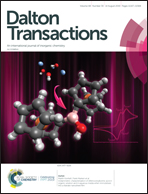Formation of nanocluster {Dy12} containing Dy-exclusive vertex-sharing [Dy4(μ3-OH)4] cubanes via simultaneous multitemplate guided and step-by-step assembly†
Abstract
The formation of high-nuclearity clusters of lanthanide usually involves many complicated self-assembly processes. Thus, tracking the formation process is extremely difficult and research on the assembly mechanism is very rare. In this study, a Dy-exclusive nanocluster containing vertex-sharing [Dy4(μ3-OH)4] cubanes, denoted as [Dy12(L)8(OH)16(CH3O)8(H2O)8]·(CH3O)4 (Dy12, L = quinoline-2-carboxylate), was designed and synthesized from L and DyCl3·6H2O. Eight quinoline-2-carboxylate ligands were encapsulated on the periphery of the Dy12 cluster, which served to stabilize the core. The high stability of the Dy12 cluster core was further confirmed by high-resolution electrospray-ionization mass spectrometry (HRESI-MS). With increased ion-source energy, only CH3O− and OH− bridging ligands were replaced inside the Dy12 cluster. Notably, eight intermediate fragments were successfully observed from the Dy12 cluster formation by time-dependent HRESI-MS. First, ligand L captured Dy3+ to give Dy1, which further formed Dy2 through μ2-O bridging. The Dy12 cluster was constructed in one step with four Dy2 and four Dy3+ as templates: L → Dy1 → Dy2 → Dy12. Moreover, a series of Dy3–Dy6 fragment peaks with relatively weak intensities were observed, and an alternative stepwise-assembly route was proposed: L → Dy1 → Dy2 → Dy3 → Dy4 → Dy5 → Dy6 → Dy12. On comparing the two different assembly methods, the multitemplate guided assembly formed Dy12 was found to be dominant. To the best of our knowledge, this study was the first to propose the involvement of two self-assembly mechanisms in the construction of lanthanide clusters, as further confirmed by HRESI-MS. Magnetic studies further showed that Dy12 clusters exhibited field-induced single-molecule magnet behavior.
![Graphical abstract: Formation of nanocluster {Dy12} containing Dy-exclusive vertex-sharing [Dy4(μ3-OH)4] cubanes via simultaneous multitemplate guided and step-by-step assembly](/en/Image/Get?imageInfo.ImageType=GA&imageInfo.ImageIdentifier.ManuscriptID=C9DT01454C&imageInfo.ImageIdentifier.Year=2019)


 Please wait while we load your content...
Please wait while we load your content...